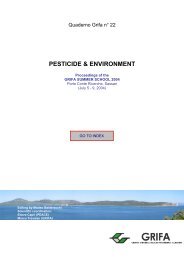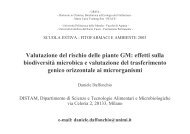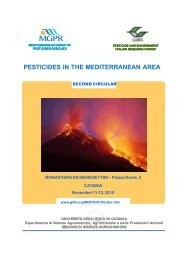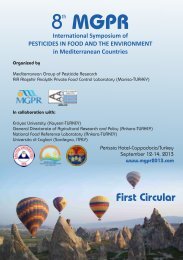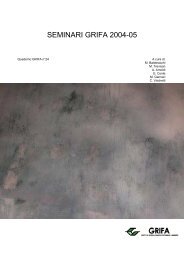International Congress BIOLOGICAL PRODUCTS - Gruppo di ...
International Congress BIOLOGICAL PRODUCTS - Gruppo di ...
International Congress BIOLOGICAL PRODUCTS - Gruppo di ...
You also want an ePaper? Increase the reach of your titles
YUMPU automatically turns print PDFs into web optimized ePapers that Google loves.
Tab. III - Residui <strong>di</strong> timolo(mg/Kg) nel miele (Me<strong>di</strong>a±Dev.St.).<br />
Formulazione Prelievo a 7gg Prelievo a 14gg Prelievo a 7gg Prelievo a 14gg<br />
dal 1° tratt. dal 1° tratt. dal 2° tratt. dal 2° tratt.<br />
Api Life Var® 1,97±1,54 0,75±0,44 1,05±1,01 0,62±0,57<br />
Apiguard 3,07±1,80 0,89±0,70 2,55±3,50 0,96±0,61<br />
In generale, i residui nel miele si presentano altamente variabili come già riscontrato da Bogdanov et al. (1998). Tenuto<br />
conto che si tratta <strong>di</strong> un composto molto volatile, la variabilità potrebbe essere in funzione delle <strong>di</strong>fferenti con<strong>di</strong>zioni<br />
microclimatiche che possono verificarsi negli alveari in rapporto alle <strong>di</strong>verse con<strong>di</strong>zioni biologiche delle colonie.<br />
I residui <strong>di</strong> timolo nei campioni <strong>di</strong> cera, prelevati prima e al termine della quarta settimana <strong>di</strong> trattamento, sono riportati<br />
nelle tabella IV.<br />
Tab.IV - Residui <strong>di</strong> timolo (mg/Kg) nella cera (Me<strong>di</strong>a±Dev.St.).<br />
Formulazione Prima del trattamento Alla fine del trattamento<br />
Api Life Var® n.d. 21,6±13,0<br />
Apiguard 1,0±0,7 147,7±188,9<br />
Nei campioni <strong>di</strong> cera prelevati prima del trattamento dagli alveari testimone, la concentrazione del timolo, quando<br />
presente, ha valori pari a 2,9 ± 4,6 mg/Kg, alla fine del trattamento i valori sono <strong>di</strong> 1,5 ± 0,8 mg/Kg. La medesima<br />
natura apolare <strong>di</strong> timolo e cera comporta evidentemente una maggiore presenza del composto nella cera stessa piuttosto<br />
che nel miele.<br />
In definitiva, sulla base dei risultati acquisiti nel presente stu<strong>di</strong>o, si conferma la buona efficacia del timolo, in<br />
riferimento alle due <strong>di</strong>fferenti formulazioni testate, nel controllo della Varroosi in apiario, con una riduzione percentuale<br />
me<strong>di</strong>a dell’infestazione del 90 % e del 95% circa se riferita alla covata o alle api adulte. Questi risultati, comparati con<br />
quelli ottenuti con altri acarici<strong>di</strong> nello stesso ambiente (Floris et al., 2001; Floris et al., 2001), <strong>di</strong>mostrano la vali<strong>di</strong>tà del<br />
timolo, seppure con una modesta incidenza negativa del trattamento sullo sviluppo delle colonie, come mezzo<br />
alternativo agli acarici<strong>di</strong> <strong>di</strong> sintesi per il controllo della Varroa, con il vantaggio che, trattandosi <strong>di</strong> un composto <strong>di</strong><br />
origine naturale, non presenta alcun limite massimo <strong>di</strong> residuo nel miele (Imdorf et al., 1999; Wallner, 1999).<br />
BIBLIOGRAFIA<br />
Bogdanov S., Imdorf A., Kilchenmann V., 1998 - Residues in wax and honey after Apilife Var treatment. Apidologie<br />
1998, 29, 513-524.<br />
Calderone N.W., 1999 – Evaluation of formic acid and Thymol-based blend of natural products for fall control of<br />
Varroa jacobsoni (Acari: Varroidae) in colonies of Apis mellifera (Hymenoptera: Apidae). J. Econ. Entomol.,<br />
92(2): 253-260.<br />
Floris I., Cabras P., Garau V.L., Minelli E. V., Satta A., Troullier J., 2001 - Persistence and Effectiveness of Pyretroids<br />
in Plastic Strips Against Varroa Jacobsoni (Acari: Varroidae) and Mite Resistance in a Me<strong>di</strong>terranean Area. J.<br />
Econ. Entomol. 2001, 94(4): 806-810.<br />
Floris I., Satta A., Garau V.L., Melis M., Cabras P., Aloul N., 2001 - Effectivness, persistence, and residue of amitraz<br />
plastic strips in the apiary control of Varroa destructor. Apidologie 2001, 32, 557-585.<br />
Henderson C. F., Tilton E. W., 1955 - Tests with acaricides against brown wheat mite. J. Econ. Entomol., 1995, 48,<br />
157-161.<br />
Imdorf A., Bogdanov S., Ibáñez Ochoa R., Calderone N.W., 2001 – Use of essential oils for the control of Varroa<br />
jacobsoni Oud. In honey bee colonies. Apidologie, 30 (2-3): 209-228.<br />
Martel A.C., Zeggane S. – Determination of acaricides in honey by high-performance liquid chromatography with<br />
photo<strong>di</strong>ode array detection. Journal of Chromatography A. 954(1-2):173-180, 2002 Apr 19.<br />
Milani N., 1999 – The resistance of Varroa jacobsoni Oud. to acaricides. Apidologie, 30 (2-3): 229-234.<br />
Nozal M.J., Bernal J.L., Jimenez J.J., Gonzales M.J. Higes M., 2002 – Extraction of thymol, eucalyptol, menthol, and<br />
camphor residues from honey and beeswax – Determination by gas chromatography with flame ionization<br />
detection. Journal of Chromatography A. 954(1-2):207-215, 2002 Apr 19.<br />
Their H.P., Zeumer H., - 1987 – Manual of Pesticides Residues Analysis: VCH: Weinheim, Germany, Vol.1, pp. 37-74.<br />
Wallner K., 1999 - Varroacides and their residues in bee products. Apidology, 1999, 30, 235 -248.<br />
Whittington R., Winston M.L., Melathopoulos A.P., Higo H.A., 2000 – Evaluation of the botanical oils neem, thymol,<br />
and canola sprayed to control Varroa jacobsoni Oud. (Acari: Varroidae) and Acarapis woo<strong>di</strong> (Acari:<br />
Tarsonemidae) in colonies of honey bees (Apis mellifera L., Hymenoptera: Apidae). American Bee Journal, 140<br />
(7): 567-572.<br />
PDF creato con FinePrint pdfFactory versione <strong>di</strong>mostrativa http://www.secom.re.it/fineprint<br />
83



